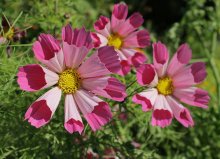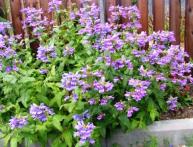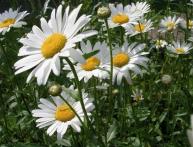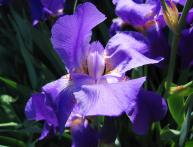Cosmea: planting and caring for a flower from childhood

Affectionately called “beauty,” the plant is a traditional decoration for the garden. It has long been a favorite of gardeners, who use it in group plantings and cut it for unusual bouquets.
Content:
Portrait of a cosmos
The plant is a representative of the Asteraceae family. This herb is native to the American tropics and subtropics. Mexicans can admire most types of cosmos. Residents of mid-latitudes are content with only three - two annuals and one perennial.
The name of the plant comes from the Greek word “kosmeo” - beauty, orderliness, balance. Therefore, the flower received its second name - cosmos. The people awarded him the unpleasant nickname “disheveled young lady.” It's all because of the delicate, delicate foliage that looks like tangled strands.
Plant height is 50-150 cm. Erect, flexible, thin stems are crowned with daisy-like inflorescences. These are single baskets or baskets collected in panicles with a diameter of up to 12 cm. Breeders have worked hard to breed new plant varieties. During the flowering period, cosmos colors the flowerbed in white, pink, crimson, and golden tones. In addition to long-cultivated species, decorative double flowers have appeared.
The fruit is a dark yellow, gray or brown achene. Planting material retains its properties for 2-3 years after harvesting.
When collecting seeds of cross-pollinated cosmos, you should not hope to reproduce all the properties of the variety next year. The grown hybrids will surprise you with all sorts of shades, but the most unusual ones will not be reproduced.
Ways to grow a flower

Plant propagated by seeds. They are sown directly into the soil or grown as seedlings.
Planting in open ground is carried out in the spring, when the snow has completely melted. Technology:
- Till the soil deeply.
- Scatter planting material on the ground in nests of 3 or 4 pieces. Maintain a distance of 30-40 cm between them.
- Press to the ground.
- Water.
- Sprinkle the seeds a little with soil so that the layer of soil is no thicker than 1 cm.
If the weather is favorable, shoots will appear in a couple of weeks. Seedlings that have grown to 5-10 cm are thinned out: weak plants are removed, about 40 cm are left between young cosmos.
When the flowers have grown to 0.5 m, pinch off the top. Such actions will increase bushiness and new inflorescences will begin to form. Plants will sparkle with colors in July or early August. Planting material can be purchased in specialized stores or collected independently. It is better to make a purchase at the end of winter.
Cosmea can withstand autumn planting. Maybe reproduce by self-sowing. Then in the spring you will have to thin out the densely sprouted plants. Growing seedlings is an effective, but more labor-intensive process. The sequence of actions for this method:
- In March-April, prepare containers with substrate.
- Sow planting material on top.
- Do not sprinkle on top, just press into the soil.
- Moisturize.
- Cover with glass or polyethylene.
Keep containers at a temperature of 18-200C.In comfortable conditions, seedlings will appear in 1-2 weeks. The seedlings are thinned to a distance of 10-15 cm between cosmos. After the procedure, the optimal temperature for plants is 16-180C. Another option is to sow several seeds in individual plastic cups.
You need to carefully select purchased seedlings. It should be compact, with a developed rhizome. Elongated and weakly branched cosmos plants are not suitable.
Both methods of propagating cosmos are quite simple, but with the seedling method, flowering will begin earlier.
Features of planting seedlings and caring for them

In May, it’s time to think about identifying the grown seedlings for a permanent place. They begin to work after waiting for stable heat. Planting seedlings:
- Prepare small holes every 30 or 35 cm
- Water them with water
- Plant the plants
- Water again
- Dig a support (slats, rods) to which you can tie the grown flower.
For cosmos that has reached a height of 50 cm, pinch off the top. Such a plant will bush better.
Space is thermophilic: it will like it in sunny areas. In the shade, it will spend all its energy on stretching stems rather than flowering. The beauty has a unique gift - to fully develop in any soil. The ideal option for it is loose soil enriched with humus. The flowerbed should be located in a place protected from drafts.
The flower is watered if it is obvious the earth is dry and at the beginning of vigorous growth. Fertilizers are not of fundamental importance. Saturation with nitrogen will lead to cosmos stretching and it will set few seeds.
The plant is practically not affected by diseases and pests. In rainy summers it is threatened by snails and slugs. Specialized stores have enough tools in their arsenal to combat them.Wilted inflorescences must be removed in time. Such actions help to maintain decorativeness at the proper level: the flowering period of the plant increases, the seeds are not sown anywhere.
The stems of tall specimens may break. To prevent this from happening, they are tied to supports. Hilling is additional support.
Cosmos bloom in summer and autumn, until the first frost. At temperatures below 00C they die immediately. Cold-damaged stems are cut off and put into compost. During the winter, the rhizome rots and becomes a good fertilizer. Even a novice gardener can cope with planting cosmos seedlings in a flowerbed and caring for them.
Growing cosmos is a pleasant hobby for people who put their soul into decorating their plot. The picky flower will gratefully enliven the interior.
Features of planting cosmos seeds in the video:
Interesting information about the vegetable garden











Comments
I planted cosmos directly in open ground. I took a flower with a white center and pink edges. The first year it grew like this, but then for some reason the flower was reborn and the cosmos became the most ordinary.